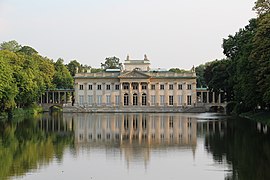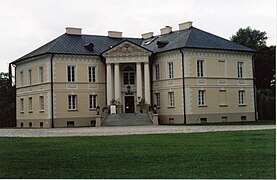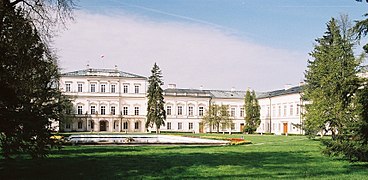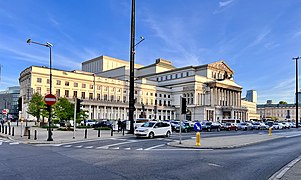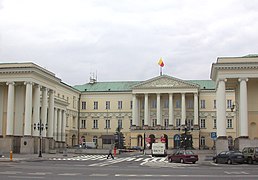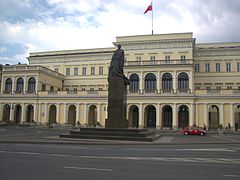Polish Enlightenment
| Part of a series on the |
| Culture of Poland |
|---|
 |
| Traditions |
|
Mythology |
| Cuisine |
| Festivals |
| Religion |
The ideas of the
History
Polish Enlightenment, while sharing many common qualities with the classical Enlightenment movements of

The differences did not end there. Townsfolk and bourgeoisie dominated Western Enlightenment movement, while in the Commonwealth most of the reformers came from szlachta (nobility). Commonwealth szlachta (forming 10% of its population) considered the idea of equality to be one of the foundations of its culture, and reformers fought to expand it towards other social classes. Religious tolerance was an ideal of the szlachta.
Constitution of 1791
Ideas of that period led eventually to the

The ideas of the Polish Enlightenment also had a significant impact abroad. From the Bar Confederation (1768) through the period of the Great Sejm and until the aftermath of the Constitution of May 3, 1791, Poland experienced a large output of political, particularly constitutional, writing.
Important institutions of the Enlightenment included the National Theatre founded in 1765 in Warsaw by King Stanisław August Poniatowski; and in the field of advanced learning: the Commission of National Education established by the Sejm in 1773; the Society for Elementary Books; as well as the Corps of Cadets (Knight's military school) among others. In expanding the field of knowledge, there was the Society of Friends of Science set up in 1800 soon after the Partitions. Popular newspapers included Monitor and Zabawy Przyjemne i Pożyteczne (Games Pleasant and Useful).
Notable persons
- Polish theatre
- Franciszek Bohomolec - poet, writer, publisher, teacher
- Liceum Krzemienieckie
- Joachim Chreptowicz - Last Grand Chancellor of the Lithuania, journalist, poet, translator, and physiocrat
- Jakub Jasiński - poet, general, radical supporter of revolution
- Franciszek Salezy Jezierski - writer, political activist
- Franciszek Karpiński - poet
- Franciszek Kniaźnin(Franciszek Dionizy Kniażin) - poet, writer
- Hugo Kołłątaj - priest, social and political activist, political thinker, historian and philosopher
- Stanisław Konarski - precursor of education reform, author of O skutecznym rad sposobie
- Onufry Kopczyński - teacher, precursor of Polish grammar
- Tadeusz Kościuszko - military engineer, statesman, revolutionary.
- Michał Dymitr Krajewski - writer, educational activist
- Thursday dinners
- Stanisław Leszczyński - king of Poland, political activist, writer (Głos wolny wolność ubezpieczający)
- Samuel Bogumił Linde - chairman of Towarzystwo do Ksiąg Elementarnych, creator of Słownik Języka Polskiego
- Adam Naruszewicz - poet, translator, historian
- Julian Ursyn Niemcewicz - poet, playwright, independence activist
- Jan Piotr Norblin- painter
- Zakład Narodowy im. Ossolińskich
- Grzegorz Piramowicz - writer, philosopher, educational activist
- Stanisław August Poniatowski - king, co-organiser of Thursday's dinners, great supporter of arts and sciences in Poland,
- Stanisław Staszic - writer, economist
- Jan Śniadecki - astronomer, mathematician, philosopher
- Jędrzej Śniadecki - chemist
- Stanisław Trembecki - poet (Classicism style)
- Tomasz Kajetan Węgierski - poet, explorer
- Mazurek Dąbrowskiego, Polish national anthem
- Franciszek Zabłocki - poet, comedy writer, secretary of Towarzystwo do Ksiąg Elementarnych
- Biblioteka Załuskich
- kanclerz, politician, author of the Zamoyski Code
Architecture
The center of the
The first stage, called the Stanislavian style, followed by an almost complete inhibition and a period known as the
From the period of the Congress Kingdom are Koniecpolski Palace and the
- Palaces
-
Łazienki Palace, Warsaw, 1764-1795
-
Marynka's Palace, Puławy, 1790-1794
-
Królikarnia Palace, Warsaw, 1782-1786
-
Gorzeński Palace, Dobrzyca, 1795-1799
-
Presidential Palace, Warsaw, 1818
-
Staszic Palace, Warsaw, 1820-1823
-
Mostowski Palace, Warsaw, 1823-1824
-
Czartoryski Palace, Puławy, 1840-1843
- City structures
-
Działyński House, Poznań, 1773-1776
-
Zbaraski House, Kraków, 1777-1783
-
Town Hall, Siedlce, 1766-1769
-
Guardhouse, Poznań, 1783-1787
-
Great Theatre, Warsaw, 1825-1833
-
Commission Palace, Warsaw, 1823-1825
-
Treasury Ministry, Warsaw, 1825-1828
-
Bank of Poland, Warsaw, 1825–28
See also
Notes
- ^ a b Jerzy Snopek, "The Polish Literature of the Enlightenment." Archived 2011-10-05 at the Wayback Machine (PDF 122 KB) Poland.pl. Retrieved October 7, 2011.
- ^ John Stanley (March–June 2004). "Literary Activities and Attitudes in the Stanislavian Age in Poland (1764–1795): A Social System?". findarticles.com. Archived from the original on 2011-05-14. Retrieved 2009-04-23.
- ^ Manfred Kridl (1967). A survey of Polish literature and culture. Columbia University Press. pp. 192, 343.
- ^ Wojciech Słowakiewicz (2000). Wielka encyklopedia polski (in Polish). Fogra.
Further reading
- Butterwick, Richard (May 2005). "What Is Enlightenment (Oswiecenie)? Some Polish Answers, 1765-1820". Central Europe. 3 (1).
- Fiszman, Samuel; Jan Kochanowski (1988). The Polish renaissance in its European context. Indiana U.P. ISBN 9780253346278.
- Janowski, Maciej (2004). Polish Liberal Thought Before 1918. Central European University Press. ISBN 9789639241183.
- Suchodolski, Bogdan (1986). A history of Polish culture. Interpress Publishers. ISBN 9788322321423.
- Stanley, John "Towards A New Nation: The Enlightenment and National Revival in Poland," Canadian Review of Studies in Nationalism, 1983, Vol. 10 Issue 2, pp 83–110

